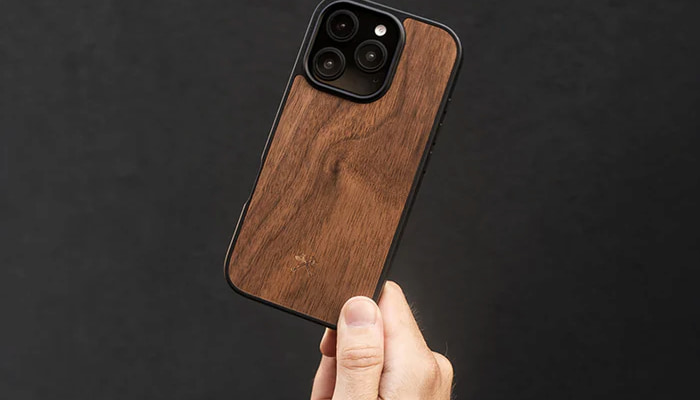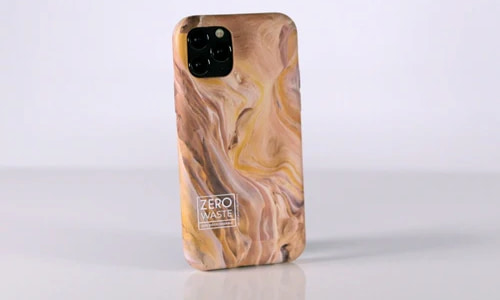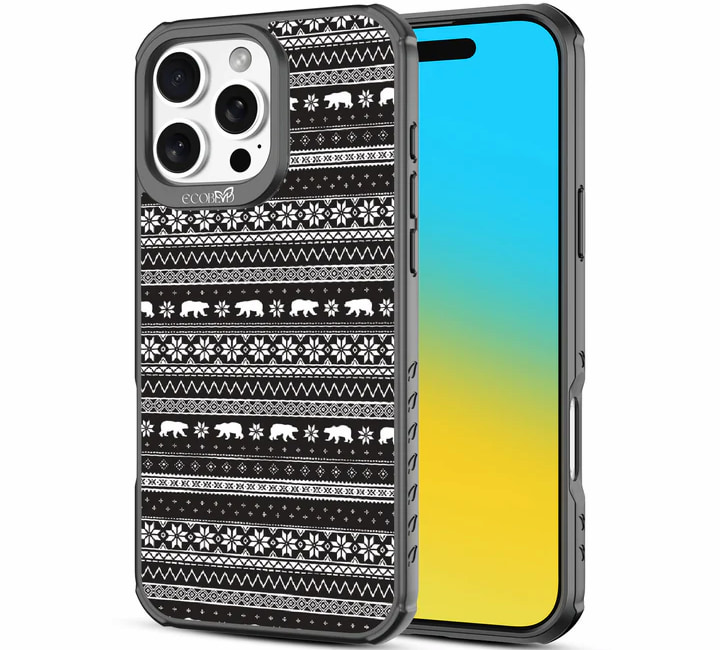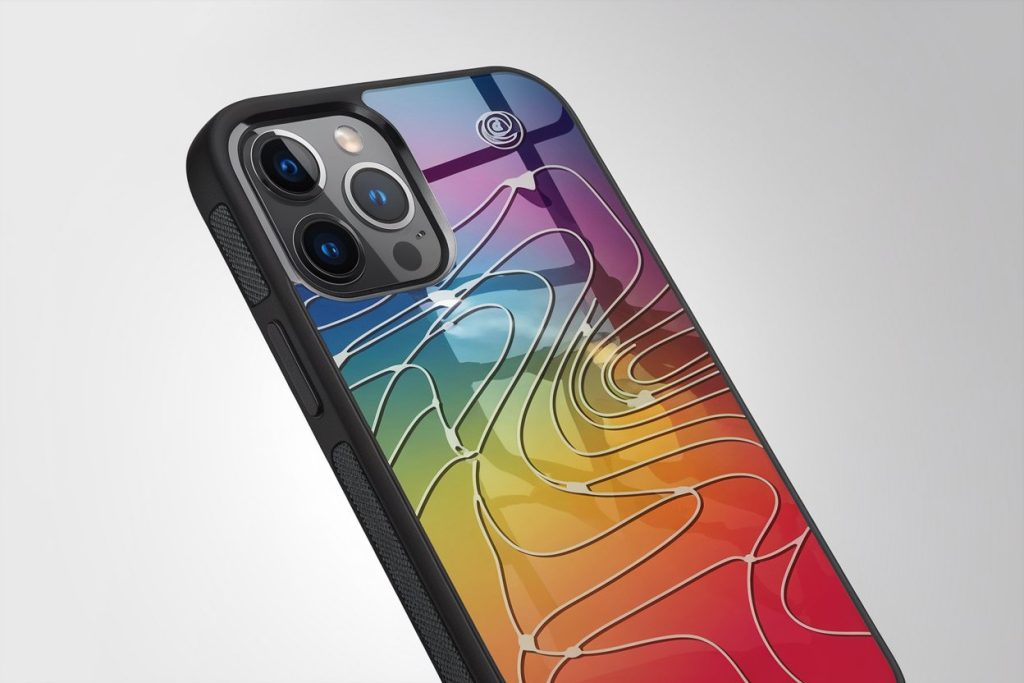Our smartphones are indispensable, accompanying us everywhere. However, the accessories we choose, like phone cases, often contain harmful chemicals and contribute to environmental pollution. Non-toxic phone cases offer a solution, combining safety with sustainability.
This article explores the best eco-friendly and sustainable options for non-toxic phone cases, helping you make informed choices that benefit both your health and the planet.
Here are some top picks for non-toxic, eco-friendly phone cases:
Best Non-Toxic Compostable Phone Cases
Compostable phone cases are a perfect blend of innovation and sustainability. These cases are designed to break down in composting conditions, leaving behind no harmful residue. For those seeking non-toxic options, they are an excellent way to protect your phone while protecting the planet.
Pela Phone Cases

Pela crafts eco-friendly phone cases from Flaxstic®, a blend of plant-based biopolymers, flax straw waste, and recycled materials. This ensures the cases are fully compostable, decomposing naturally within 6 to 24 months in a composting environment.
Design and Aesthetics
Pela offers a variety of colors and designs to suit different personal styles. The cases have a soft-touch, matte finish that provides a comfortable grip, reducing the likelihood of accidental drops.
Durability and Protection
Despite their compostable nature, Pela cases are designed to be durable, offering reasonable protection against everyday wear and tear. They provide adequate impact resistance for typical daily use, though they may not offer the same level of protection as some heavy-duty, non-compostable cases.
Environmental Impact
By choosing a Pela case, consumers contribute to reducing plastic waste. Pela is a B Corporation and Climate Neutral Certified, reflecting its commitment to environmental sustainability. Additionally, Pela donates a portion of its sales to environmental non-profit organizations, further supporting eco-friendly initiatives.
Customer Feedback
Pela has received positive feedback from customers, with an average rating of 4.9 out of 5 based on over 57,000 reviews. Users appreciate the cases’ design, eco-friendliness, and durability. However, some customers have noted that the cases can be more susceptible to staining and discoloration compared to plastic cases, and may require extra care to maintain their appearance.
Pricing
Pela cases are generally priced between $30 and $60, which is higher than conventional plastic cases. This price point reflects the use of sustainable materials and eco-friendly production processes. Pela often offers discounts and promotions, providing opportunities for more affordable purchases.
Pros:
- Made from compostable and biodegradable materials, reducing plastic waste.
- Wide range of colors and patterns to suit various tastes.
- Soft-touch finish enhances handling and reduces slip risk.
- Certified B Corporation and Climate Neutral Certified, with charitable contributions to environmental causes.
Cons:
- More expensive than conventional plastic cases.
- May be more prone to discoloration and require extra care.
- While durable, may not offer the same level of protection as some heavy-duty cases.
Woodcessories eco-friendly phone cases

Woodcessories offers a range of eco-friendly phone cases that blend sustainability with functionality. Their products are crafted from natural materials, including wood, stone, and plant-based biopolymers, providing an environmentally conscious alternative to conventional plastic cases.
Design and Aesthetics
Woodcessories’ phone cases are known for their unique and natural appearance. Each case showcases the distinct grain patterns of the materials used, ensuring that no two cases are identical. The use of real wood and stone adds a touch of elegance and sophistication to your device. Additionally, the cases are designed to be slim and lightweight, maintaining the sleek profile of modern smartphones.
Durability and Protection
The combination of hard and soft materials offers shock absorption and resistance to everyday wear and tear. Some models feature reinforced corners and raised edges to safeguard the screen and camera. However, it’s important to note that while these cases offer substantial protection, they may not be as impact-resistant as some heavy-duty plastic alternatives.
Environmental Impact
Woodcessories is committed to sustainability. Their use of natural and biodegradable materials helps reduce plastic waste. The company also implements eco-friendly production processes and packaging. By choosing a Woodcessories case, consumers contribute to environmental conservation efforts.
Pros:
- Made from natural, biodegradable resources, reducing environmental impact.
- Each case has a distinct appearance due to the natural grain patterns of wood and stone.
- Maintains the sleek profile of your smartphone without adding bulk.
- Adequate Protection: Provides reasonable defense against daily wear and minor drops.
Cons:
- Natural materials may offer fewer color choices compared to synthetic cases.
- Natural materials might show signs of aging or wear over time.
- May not offer the same level of protection as some heavy-duty plastic cases.
Wilma’s biodegradable phone cases

Wilma’s biodegradable phone cases offer an eco-friendly alternative to traditional plastic cases. Crafted from 100% biodegradable materials, these cases aim to reduce environmental impact without compromising on device protection.
Design and Aesthetics
Wilma’s cases feature bold designs inspired by nature, combining fashion with sustainability. The use of natural plant fibers gives each case a unique texture and appearance. Available in various colors, including red, they cater to diverse personal styles. The slim profile ensures that the case adds minimal bulk to the iPhone 12 Mini, maintaining the device’s sleek design.
Durability and Protection
Wilma’s cases provide shock absorption and safeguard the phone against drops and scratches, comparable to conventional plastic cases. The precise cutouts ensure easy access to all ports and buttons, maintaining the device’s functionality.
Environmental Impact
Wilma is committed to environmental sustainability. Their cases are free from environmentally harmful ingredients and degrade naturally without leaving any residue. The packaging is also eco-friendly, made from recycled cardboard and printed with soy-based inks, further reducing the ecological footprint.
Pros:
- Made from 100% biodegradable, plant-based materials, reducing plastic pollution.
- Bold, nature-inspired aesthetics available in various colors.
- Offers shock absorption and defense against drops and scratches.
- Uses recycled cardboard and soy-based inks for packaging.
Cons:
- Biodegradable materials may not match the long-term durability of some high-quality plastic cases.
EcoBlvd Non Toxic Phone Cases

EcoBlvd offers eco-friendly phone cases designed to reduce environmental impact without compromising on style or protection. Their cases are crafted from plant-based materials and recycled plastics, providing a sustainable alternative to traditional phone accessories.
Design and Aesthetics
EcoBlvd’s phone cases feature a variety of designs, including festive holiday patterns and classic styles, catering to diverse personal preferences. The cases maintain a slim profile, ensuring they complement the sleek design of modern smartphones. Additionally, EcoBlvd offers customization options, allowing users to personalize their cases.
Durability and Protection
Despite their eco-friendly materials, EcoBlvd’s cases are engineered to provide robust protection for smartphones. The Mojave Collection, for instance, is designed to withstand impacts and protect devices from everyday damage, comparable to conventional plastic cases.
Environmental Impact
EcoBlvd is committed to sustainability, utilizing plant-based materials and recycled plastics in their products. Their cases are designed to be recyclable or compostable, reducing plastic pollution. The company also uses FSC-certified, non-plastic packaging and includes a free prepaid shipping label for customers to return old cases and chargers for recycling or proper disposal.
Pros:
- Crafted from plant-based materials and recycled plastics, reducing environmental impact.
- Offers a variety of designs, including customizable options, to suit different tastes.
- Engineered to provide robust protection comparable to conventional plastic cases.
- Uses FSC-certified, non-plastic packaging and offers recycling programs for old accessories.
Cons:
- While EcoBlvd offers cases for various phone models, availability may be limited for less common devices.
A Good Company biodegradable phone cases

A Good Company offers compostable mobile cases crafted from plant-based materials, providing a sustainable alternative to traditional plastic cases.
Design and Aesthetics
These cases feature a slim profile and a textured surface for improved grip. They are available in various colors and artist-designed patterns, allowing users to express their personal style.
Durability and Protection
The 1.2 mm thickness and raised edges help safeguard the phone’s screen and camera.
Environmental Impact
A Good Company is committed to sustainability, utilizing linseed surplus from local farmers to produce their cases. The production process is 100% cyclical, and the company offers a recycling program where customers can return old cases to be made into new ones.
Pros:
- Made from 100% plant-based materials, reducing environmental impact.
- Provides adequate protection with a slim profile.
- Encourages sustainability through a case recycling initiative.
Cons:
- While protective, plant-based materials may not match the long-term durability of some high-quality plastic cases.
Comparing Non-Toxic Phone Case Brands
| Brand | Material | Key Features | Environmental Impact | Durability | Price Range |
|---|---|---|---|---|---|
| Pela Phone Cases | Flaxstic® (Plant-based biopolymers, flax straw waste, recycled materials) | Compostable, soft-touch finish, matte grip | Certified B Corporation, Climate Neutral Certified | Durable for everyday wear; moderate impact resistance | $30 – $60 |
| Woodcessories | Wood, stone, plant-based biopolymers | Unique grain patterns, slim and lightweight | Uses natural and biodegradable materials, eco-friendly production | Moderate impact resistance | $40 – $80 |
| Wilma | 100% biodegradable plant-based materials | Bold designs, shock absorption | Eco-friendly packaging, natural decomposition | Shock absorption; comparable to conventional cases | $25 – $50 |
| EcoBlvd | Plant-based materials and recycled plastics | Variety of designs, customizable | Recyclable or compostable, FSC-certified packaging | Comparable to plastic cases | $30 – $55 |
| A Good Company | Plant-based materials (linseed surplus) | Textured surface, slim profile | 100% cyclical production, recycling program for old cases | 1.2mm thickness, raised edges | $35 – $60 |
What Are Non-Toxic Phone Cases?
Non-toxic phone cases are protective covers designed without the use of harmful chemicals like BPA, phthalates, or heavy metals. These cases prioritize the health and safety of both the user and the environment. Typically made from biodegradable, compostable, or recyclable materials, they provide effective phone protection while minimizing environmental impact. Their key features include:
- Use of plant-based or recycled materials.
- Absence of harmful substances that can leach into the environment.
- Durability and aesthetic appeal on par with conventional cases.
Why Non-Toxic Materials Matter
Traditional phone cases are often made from plastics and other synthetic materials that contain toxic compounds. These substances can pose health risks during production, use, or disposal. When discarded, such materials contribute to environmental pollution, leaching chemicals into the soil and water.
Non-toxic materials, in contrast, eliminate these risks. By opting for non-toxic phone cases, you not only ensure your own safety but also contribute to reducing the global reliance on harmful plastics. These cases support sustainable practices, promote a circular economy, and significantly lower the ecological footprint of everyday products.
How Biodegradable Cases Work
Biodegradable phone cases are designed to decompose naturally when exposed to specific environmental conditions. They are typically made from plant-based materials such as cornstarch, bamboo fibers, or wheat straw. Here’s how they work:
- Composition: The materials used are organic and break down into natural elements like carbon dioxide, water, and biomass.
- Decomposition Process: When discarded in a composting environment, microorganisms digest the case material, accelerating the decomposition process.
- Environmental Impact: Unlike traditional plastics, biodegradable cases do not release toxins or microplastics, ensuring a cleaner, safer environment.
What Does Compostable Mean?
Compostable phone cases take biodegradability a step further. They are specifically designed to break down within a set time frame in composting conditions. Here’s what makes a case compostable:
- Complete Breakdown: Compostable cases decompose entirely into non-toxic, nutrient-rich matter, often within six months to two years.
- Home vs. Industrial Composting: Some cases are suitable for home composting, while others require the higher temperatures and controlled conditions of industrial composting facilities.
- Zero Residue: Compostable products leave no microplastic or harmful residue behind, making them an ideal choice for eco-conscious consumers.
Choosing a non-toxic, biodegradable, or compostable phone case reflects a commitment to healthier living and environmental responsibility. These options prove that sustainability and functionality can go hand in hand, offering peace of mind while making a positive impact on the planet.
The Issues with Conventional Phone Cases

Conventional phone cases, typically made from hard plastics and synthetic materials, often contain harmful chemicals. These include substances like BPA, phthalates, and heavy metals, which are used to enhance durability, flexibility, or color vibrancy. While these chemicals improve functionality, they pose significant risks:
- Health Risks: Prolonged exposure to these toxins, either through skin contact or environmental leaching, can disrupt hormones, damage organs, or even contribute to long-term illnesses.
- Chemical Leaching: Over time, these chemicals can seep out of the plastic, especially when exposed to heat or sunlight. This leaching contaminates the environment and can expose users indirectly to harmful compounds.
- Persistent Pollution: The chemicals in plastic don’t degrade naturally, leading to accumulation in ecosystems and food chains.
Environmental Impact of Standard Phone Cases
Standard phone cases are made from petroleum-based plastics, which take hundreds of years to degrade. Their production, use, and disposal create a cascading chain of environmental damage:
- Carbon Footprint: The manufacturing process for plastic cases involves extracting, refining, and processing fossil fuels, emitting significant amounts of greenhouse gases.
- Waste Accumulation: When disposed of, these cases often end up in landfills, where they contribute to the growing crisis of plastic pollution.
- Microplastic Pollution: As plastic breaks down into smaller fragments, it creates microplastics that infiltrate soil, waterways, and even the air, threatening wildlife and ecosystems.
- Non-Renewable Resource Dependence: The reliance on finite fossil fuels for these products exacerbates global resource depletion.
The ubiquity of plastic phone cases makes their impact easy to overlook, but the harm they cause is substantial. Transitioning to non-toxic, sustainable alternatives isn’t just a personal choice—it’s a step toward addressing a global problem that affects both human health and the planet. By choosing eco-friendly options, consumers can actively reduce their footprint while still enjoying practical and stylish protection for their devices.
How to Choose a Non-Toxic Phone Case
When selecting a non-toxic phone case, the materials used play a crucial role. Sustainable and natural materials are not only safer for you but also better for the environment. Here are some of the top eco-friendly materials to consider:
Bamboo
- Bamboo is a fast-growing, renewable resource that requires minimal water and no pesticides.
- It is lightweight yet durable, making it an excellent choice for phone cases.
- Bamboo cases often feature a natural wood grain finish, providing a sleek and unique appearance.
Cork
- Cork is harvested from the bark of cork oak trees, a process that doesn’t harm the tree.
- It’s naturally water-resistant, shock-absorbent, and biodegradable.
- Cork cases are lightweight and offer a unique, earthy texture that stands out.
Hardwood
- Cases made from responsibly sourced hardwoods like walnut or maple are durable and stylish.
- They provide a natural, premium look while offering excellent protection.
- It’s essential to ensure the wood is FSC-certified to confirm sustainable sourcing.
Durability and Protection
A good non-toxic phone case should offer reliable protection for your device. Look for features like shock absorption, raised edges to safeguard the screen and camera, and compatibility with drop tests. Eco-friendly materials like bamboo and hardwood are naturally sturdy, while cork provides cushioning for added safety.
Style and Compatibility
Non-toxic phone cases don’t sacrifice style. Many options are available in various colors, patterns, and textures to suit your personal taste. Additionally, ensure the case is compatible with your device model and features like wireless charging. A snug fit and precise cutouts for buttons and ports are essential for usability.
Verified Customer Reviews
Before making a purchase, check customer reviews to understand the real-world performance of the case. Look for feedback on:
- Durability: Does the case hold up to daily use?
- Fit and Functionality: Are the cutouts accurate, and does it fit the phone securely?
- Eco-Credentials: Does the case deliver on its promise of being environmentally friendly?
Customer reviews can provide valuable insights and help you choose a case that aligns with your priorities and expectations.
Benefits of Using Non-Toxic Phone Cases
1. Safer for You and Your Family
Non-toxic phone cases eliminate exposure to harmful chemicals commonly found in traditional plastics. Substances like BPA, phthalates, and heavy metals are absent, reducing potential risks to your health. These chemicals can leach into your skin or release harmful toxins over time, particularly when exposed to heat.
For families, non-toxic phone cases offer peace of mind. Children are especially vulnerable to chemical exposure, and choosing non-toxic materials ensures they’re not inadvertently exposed while handling your phone. By opting for safer alternatives, you protect yourself and your loved ones from unnecessary health hazards.
2. Reducing Environmental Impact
Traditional plastic phone cases contribute significantly to global plastic pollution. Non-toxic phone cases, however, are often made from biodegradable, compostable, or recyclable materials. This means:
- They break down naturally without leaving harmful residues.
- They reduce dependence on fossil fuels used in conventional plastic production.
- They help decrease landfill waste and ocean pollution.
Switching to non-toxic phone cases is a simple yet impactful way to lower your carbon footprint and support a healthier planet.
3. Supporting Ethical Companies
When you choose non-toxic phone cases, you’re often supporting brands committed to sustainability and ethical practices. These companies:
- Use environmentally friendly production methods.
- Promote fair labor practices and transparent supply chains.
- Contribute to environmental initiatives like reforestation or plastic waste cleanup programs.
By aligning your purchasing decisions with brands that prioritize people and the planet, you encourage more companies to adopt similar practices. This collective consumer action drives meaningful change, creating a ripple effect that extends far beyond a single phone case.
FAQ
What’s the Difference Between Biodegradable and Compostable?
Biodegradable and compostable are often used interchangeably, but they have distinct meanings:
Biodegradable: A biodegradable material breaks down naturally into simpler compounds like water, carbon dioxide, and biomass. This process can occur in various environments, but it may take a long time, and not all biodegradable materials are entirely eco-friendly.
Compostable: Compostable materials decompose under specific conditions, typically in a composting environment, and leave behind no harmful residues. Compostable items break down faster than biodegradable ones and enrich the soil with nutrients.
When selecting a phone case, look for certifications that clarify whether it is biodegradable, compostable, or both, to ensure your purchase aligns with your sustainability goals.
Are Non-Toxic Cases Durable Enough?
Yes, non-toxic phone cases are designed to be durable. While they are made from eco-friendly materials like bamboo, cork, or biopolymers, these materials are engineered to provide excellent protection against everyday wear and tear. Many brands incorporate shock-absorbing designs and reinforced edges to ensure their cases withstand accidental drops and impacts.
However, it’s important to note that the longevity of any case depends on how it’s used. With proper care, non-toxic cases can offer the same level of durability as their plastic counterparts, all while being gentler on the planet.
Do Eco-Friendly Phone Cases Protect as Well as Regular Cases?
Eco-friendly phone cases are just as protective as regular cases when designed with functionality in mind. Most reputable brands perform rigorous testing to ensure their products meet industry standards for impact resistance, scratch protection, and durability.
Materials like cork and bamboo naturally provide excellent cushioning, while bioplastics can mimic the flexibility and strength of traditional plastics. Some eco-friendly cases even surpass conventional ones in protection, offering reinforced edges or dual-layer designs.
Are Non-Toxic Cases Affordable?
Non-toxic phone cases are often competitively priced, though they may sometimes cost slightly more than generic plastic cases. This price difference reflects the sustainable materials, eco-conscious production methods, and ethical practices involved.
While the upfront cost might be higher, the long-term benefits—such as reduced environmental impact and the peace of mind that comes with avoiding harmful chemicals—often outweigh the price difference. Additionally, many brands offer discounts or bundle deals, making it easier to invest in a case that aligns with your values.